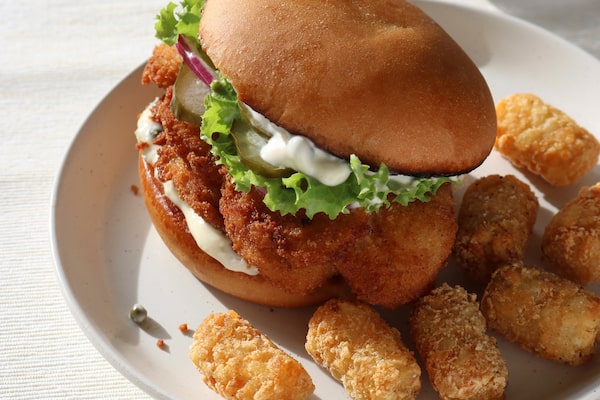
Many mushroom varieties, such as the common white button, come with a full set of amino acids, making them complete sources of protein.Julie Van Rosendaal/The Globe and Mail
In a world that’s moving away from meat, mushrooms are magical. The spore-bearing bodies of fungi, one of the most abundant and diverse groups of organisms on Earth, have a uniquely meaty texture. The edible ones deliver plenty of umami, particularly when heat activates the Maillard reaction, a scientific term for surface browning, which produces deep, complex flavour compounds.
Many mushroom varieties, such as the common white button, come with a full set of amino acids, making them complete sources of protein. Some, such as oyster mushrooms and white buttons, contain as much protein, by weight, as dairy milk. (According to the Canadian Nutrient Database, each offers a minimum three grams of protein per 100-gram serving.)
It’s more than the colours and textures of mushrooms, and their sponge-like ability to absorb flavours, that make them a popular stand-in for meat. They can be roasted, grilled or fried; shredded to mimic pulled pork; or finely chopped and sautéed, much like ground meats, for savoury pastry fillings, patties and pasta sauces, even in combination with chopped nuts or soft lentils.
A few years ago, Australian chef Jim Fuller, co-founder of Fable Foods, a company that produces a meat alternative made from shiitake mushrooms (@jimboilsmushrooms on Instagram), famously advised boiling mushrooms before browning or grilling them as a means of drawing out moisture and improving their texture. His suggestion was controversial, but many plant-based chefs found boiling made mushrooms denser, less soggy and more meat-like. The advice spurred more than 3.5 billion views of boiled-mushroom content on TikTok. (Some find boiled mushrooms unappealingly rubbery. As with all food, let your own taste dictate how you approach things in the kitchen.)
Our limited grocery store options don’t reflect the staggering biodiversity of mushrooms, but home cooks are venturing beyond buttons, creminis and portobellos. It doesn’t hurt that the variety of shapes and textures is endearing, from muppet-like lions’ manes to dainty, crunchy enokis.
There is also ruffled maitake, meaning “dancing mushroom” in Japanese, also known as hen of the woods for its resemblance to a hen on her perch. A roasted whole one makes a stunning centrepiece. Citrusy chanterelles and earthy morels are amazing with cream and pasta. The thick stems of king oyster mushrooms, which look like caricatures of themselves, make perfect, inexpensive fried “calamari.” And a few regular oyster mushrooms, separated from their cluster, make the most delicious fried-chicken-style sandwiches.
Meatless recipe: Fried Oyster Mushroom Sandwiches
This same technique can be used to make mushroom “calamari.” To do that, use king oyster mushrooms, if you can find them. Slice the thick stems and cut out the middles with a sharp knife or the end of a round metal piping tip, to make rings. Cut the caps into strips and batter and cook as directed. To make tartar sauce for your sandwich or calamari, stir grated pickles and chopped capers into mayo. (A tiny bit of grated onion or shallot is tasty, too.)
3/4 cup all-purpose flour
1/4 cup cornstarch
2 tsp paprika
2 tsp garlic powder
1 tsp onion powder
2 tsp salt
1 tsp black pepper
Oat milk (preferably barista-style, which is thicker) or buttermilk
Dry breadcrumbs or panko
1/2 lb oyster mushrooms
Canola or other vegetable oil, for cooking
4 soft buns
Butter, margarine or mayonnaise
Tartar sauce, hot sauce or hot honey
Sliced pickles, lettuce or other toppings
In a shallow dish, combine the flour, cornstarch, paprika, garlic powder, onion powder, salt and pepper. Pour some oat milk or buttermilk into another shallow dish (I like to season the milk with some salt, garlic and onion powder too) and put some breadcrumbs in a third.
Tear larger oyster mushrooms from their cluster (remove the stems if you like – they can be tough) and dip each in the milk, turning to coat. Keeping one hand to dip into the wet mixture and the other hand dry, dredge each mushroom in the flour mixture, turning and sprinkling the flour mixture over it to coat. Dip back in the milk, then into the breadcrumbs, turning and sprinkling to coat, and pressing on any damp bits. Set aside. Repeat with the remaining mushrooms, pulling smaller ones off the cluster two or three together.
When all your mushrooms are coated (you’ll need two to three per sandwich), heat about an inch of oil in a shallow pot or deep skillet. When it’s hot but not smoking – a scrap of bread should sizzle when dipped in, or a thermometer should read 350 to 375 F – cook the mushrooms, turning until deep golden on each side. Transfer to a paper-towel-lined plate.
To assemble, spread your buns with butter, margarine or mayo and toast cut-side down in a hot skillet. Spread with your sauce of choice and place a few fried mushrooms on the bottom. Top with pickles and lettuce and more sauce and serve immediately. Serves about four.